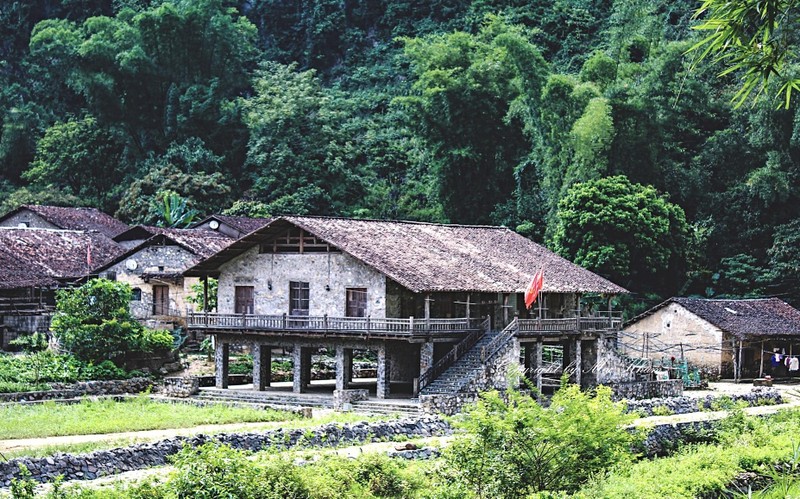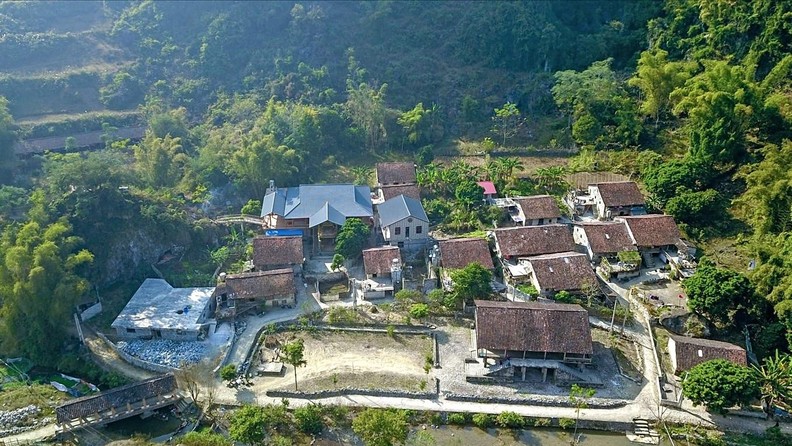One who travels to the Trung Khanh border district in northern Cao Bang province, should not miss a visit to Khuoi Ky Community-based Tourism Village in Dam Thuy commune. This small village has a strong attraction to many tourists, thanks to its natural peaceful beauty, serenity and especially the traditional stone houses.

It takes around two to three years to build a stone house on stilts. (Photo: toquoc.vn)
A place where time stands still
Khuoi Ky community-based tourism village is located on provincial road No. 206, only 2km from the famous Ban Gioc waterfall. The village was established in the period between 1594 and 1677 when the Mac dynasty moved from Thang Long to Cao Bang province.
The road leading to the village is paved with cobblestone. The village is currently home to 16 Tay ethnic households and 14 stone-built houses on stilts, which were constructed in the 16th century.
The houses in the village are surrounded by stone fences, which have existed for hundreds of years. In an area of about 10,000m2, 16 houses in Khuoi Ky stand together, symbolising the strong bond between families. The remaining area of the village is used for agricultural cultivation.
The custom of building stone houses comes from the Tay people's belief in the worshipping of the Stone God. They believe that the Stone God has strong natural powers that can protect them and bless them with a peaceful life.

Khuoi Ky village has a strong attraction to many tourists, thanks to its natural peaceful beauty and serenity (Photo: toquoc.vn)
It takes around two to three years to build a stone house on stilts. The area of the house depends on the number of people in the family.
A stone house is usually 5-7m in height with two storeys; downstairs are wooden columns built firmly on the stone foundation. The roof of the house is covered with yin-and-yang tiles, which help to keep the house cool in summer and warm in winter.
Stone is a material that plays an important role in the life of the Tay people in Khuoi Ky village. Stone is seen everywhere as it is used not only to build houses but also to make everyday items such as mills, stoves, fences, and water dams. Therefore, Khuoi Ky stone village provokes nostalgia among visitors, as if time stands still despite many historical ups and downs.
Conservation seen as the ‘key’ to tourism development
Although it houses only a dozen households, Khuoi Ky is still an exemplary community-based tourism village in Cao Bang province. In 2008, it was recognised by the Ministry of Culture, Sports and Tourism as a typical traditional cultural village of ethnic minorities.
Since 2016, thanks to the authorities’ attention and investment to support locales in developing community-based tourism, 14 local households in Khuoi Ky have participated in this model. This has helped them earn more stable sources of livelihood, and improve their quality of life.

An aerial view of Khuoi Ky village (Photo: toquoc.vn)
Trieu Thi Cap, an 80-year-old villager said that since the number of tourists to Khuoi Ky increased, the villagers have been exposed to many new things. Now, every family is actively participating in tourism activities, from offering accommodation and transporting guests, to providing agricultural products for homestays.
Children in the village can now get full access to education, while adults keep up with modern technology. “I'm glad to see that the villagers' lives have much improved,” Cap said.
Sharing his feeling about the trip to Khuoi Ky, Nguyen Van Vuong, a tourist from Ho Chi Minh City, said this is the first time he has visited the northern mountainous region. He said he was deeply impressed by the majestic natural scenery and the kindness and hospitality of the local people.
“I will never forget the warm welcome of the people, the unique stone stilt houses, and the visits to Ban Gioc waterfall and Nguom Ngao cave,” he stated.
According to the Secretary of Dam Thuy commune, Luong Van La shared that the “key” to the attraction of the Khuoi Ky Community-based Tourism Village, is the consensus and joint efforts of local people and authorities, in preserving the traditional cultural and architectural features.
“We have held regular communication activities to raise people’s understanding and appreciation of the treasured value of the ancient stone houses and traditional costumes, thus encouraging them to participate in preserving and promoting their cultural charm to visitors,” he said.
Translated by NDO